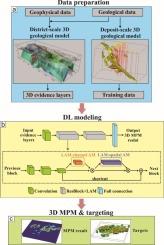Three-dimensional mineral prospectivity mapping using a residual convolutional neural network with lightweight attention mechanisms
IF 3.6
2区 地球科学
Q1 GEOLOGY
引用次数: 0
Abstract
The continuous exploration and mining of surface and shallow mineral resources have promoted subsurface exploration. Over the past decade, mineral prospectivity mapping (MPM) has progressively expanded from two-dimensional (2D) to three-dimensional (3D). The 3D convolutional neural networks (CNN) and attention mechanisms (AMs) are adept at processing 3D voxel data, offering significant advantages for 3D MPM. However, the larger computational cost in a 3D CNN–AMs model presents limitations, constraining its application to 3D MPM. This study presents a new 3D CNN architecture composed of residual blocks (ResBlocks) and a lightweight Attention Mechanism (LAM) for 3D MPM. ResBlocks incorporate skip connections to deepen the network structure, thereby enhancing its ability to model complex nonlinear patterns and mitigating the vanishing gradient problem. The LAM utilizes the dimensionality reduction fully connected layer for channel attention and depthwise separable convolution for spatial attention, thus reducing computational costs. A case study in the Wulong gold district demonstrates that the proposed architecture achieves performance improvements in 3D MPM without significant increases in numbers of parameter count and FLOPs, highlighting its efficiency and effectiveness. Furthermore, the 3D mineral targets obtained in this study are beneficial for subsurface gold exploration in the Wulong Au district, China.

基于轻量注意机制的残差卷积神经网络的三维矿产远景映射
地表和浅层矿产资源的不断勘探和开采促进了地下勘探。在过去的十年中,矿产勘查(MPM)逐渐从二维(2D)扩展到三维(3D)。三维卷积神经网络(CNN)和注意机制(AMs)擅长处理三维体素数据,为三维MPM提供了显著的优势。然而,三维CNN-AMs模型的计算成本较大,限制了其在三维MPM中的应用。本文提出了一种由残差块(ResBlocks)和轻量级注意机制(LAM)组成的3D CNN架构,用于3D MPM。ResBlocks采用跳跃连接来深化网络结构,从而增强其模拟复杂非线性模式的能力,并减轻梯度消失问题。LAM利用降维全连接层进行通道关注,利用深度可分离卷积进行空间关注,从而降低了计算成本。在武隆金矿区的实例研究表明,该架构在不增加参数数量和FLOPs数量的情况下,实现了三维MPM的性能提升,凸显了其效率和有效性。此外,本研究获得的三维找矿靶区对武隆坳地区的地下金矿找矿具有重要的指导意义。
本文章由计算机程序翻译,如有差异,请以英文原文为准。
求助全文
约1分钟内获得全文
求助全文
来源期刊

Ore Geology Reviews
地学-地质学
CiteScore
6.50
自引率
27.30%
发文量
546
审稿时长
22.9 weeks
期刊介绍:
Ore Geology Reviews aims to familiarize all earth scientists with recent advances in a number of interconnected disciplines related to the study of, and search for, ore deposits. The reviews range from brief to longer contributions, but the journal preferentially publishes manuscripts that fill the niche between the commonly shorter journal articles and the comprehensive book coverages, and thus has a special appeal to many authors and readers.
 求助内容:
求助内容: 应助结果提醒方式:
应助结果提醒方式:


